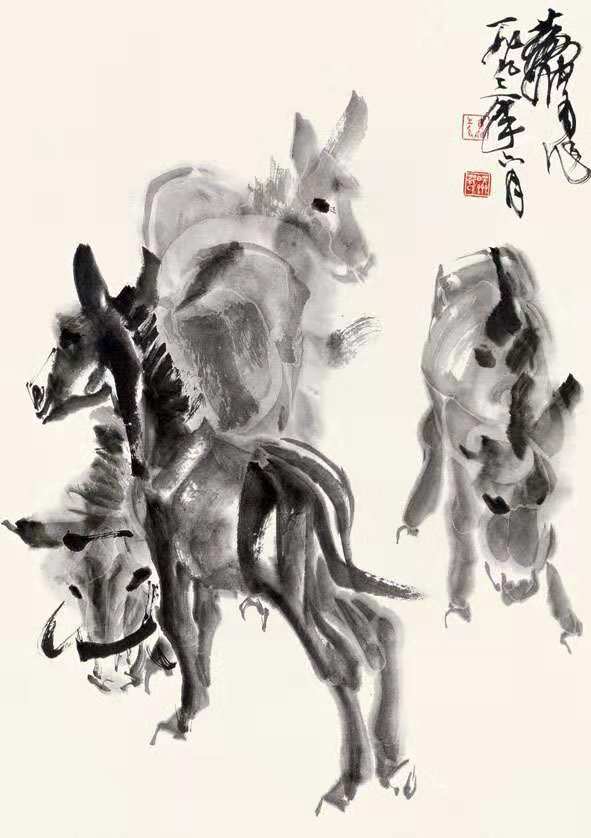名人字画判定字画的辅佐依据
The supporting basis for judging calligraphy and painting by celebrity calligraphy and painting
1.题跋,书画的题跋包括作者的题跋(上、下款)、与作者一起代人的题跋和后人的题跋。作者题跋的内容大多数是为了阐明这件著作为谁而作,为何而作,一起代人的题跋内容大多为阐明这著作的创造进程和赞扬作者的技法等。后人题跋则是考证其真伪和保藏源流等。题跋是书画判定中的一个需求注意的地方,作者题跋的不同格局(或曰“署款格局”)是书画判定的依据之一。
1. The inscriptions and postscripts of calligraphy and painting include the author's inscriptions and postscripts (upper and lower paragraph), the inscriptions and postscripts of generations together with the author and those of future generations. The content of the author's postscript is mostly to clarify for whom and why the work was written. The content of the postscript of a generation is mostly to clarify the creation process of the work and to praise the author's techniques and so on. The postscript is a textual research on its authenticity and preservation. The different patterns of the author's inscriptions and postscripts (or "the pattern of signing funds") are one of the bases for the determination of calligraphy and painting.
2.印章书画上的印章一般有两类:一类是书画家自己的印章,在作书之后,加钤印章,以表示该书画确为自己所作;另一类是鉴赏或保藏章,保藏者和鉴赏者用此表示自己的判定和保藏。印章既然是一种证明物,也就成为书画判定中判断著作真伪的辅佐依据之一。
2. Seals on paintings and calligraphy generally have two kinds: one is the painter's own seal, which is added after the book is written to indicate that the painting and calligraphy is indeed made for itself; the other is the appreciation or preservation seal, which is used by the preserver and the appreciation to express their own judgment and preservation. Since seal is a kind of proof, it also becomes one of the auxiliary bases for judging the authenticity of works in the judgment of calligraphy and painting.

3.纸绢传统的卷轴书画一般都写画在纸绢上,不一起代的纸绢,有不同的特色,在不同的纸绢上写字作画,便会出现不同的艺术作用。书画家在纸绢的选用上,往往有个人不同的喜爱,这些,对书画的判定也具有重要的参阅作用。如北宋四大书法家苏轼、黄庭坚、米芾、蔡襄都喜爱用熟纸来写字,明代董其昌喜爱用高丽镜面笺纸,其传世的大多数书画精品均用这种纸。清代刘墉、黄易、梁同书常用粉笺纸和蜡笺纸书写。书画家常依据自己的写画习气和体现技法,选用与之相适应的纸绢,以达到抱负的艺术作用。据传世著作来看,唐、五代以前的绘画,几乎全是绢本,宋今后,出现纸本,但范宽、郭熙、马远、夏圭等皆用绢本。元代高克恭、方从义等人的水墨山水画,多用纸本(元代文人山水画,皆用纸本),李衍双钩填色竹则用绢本,明代院体画家亦大都采用绢本。
3. Paper and silk traditional Chinese scroll painting and calligraphy are generally painted on paper and silk. Different generations of paper and silk have different characteristics. Writing and painting on different paper and silk will have different artistic functions. Calligraphers and painters often have different preferences in the selection of paper and silk, which also play an important reference role in the judgment of painting and calligraphy. For example, Su Shi, Huang Tingjian, Mifu and Cai Xiang, the four great calligraphers of the Northern Song Dynasty, all like to write with ripe paper. Dong Qichang of the Ming Dynasty liked to use gorgeous mirror paper, which was used in most of the fine works of calligraphy and painting handed down. In the Qing Dynasty, Liu Yong, Huang Yi and Liang Tongshu often wrote powder paper and wax paper. Calligraphers and painters often choose appropriate paper and silk according to their painting habits and techniques to achieve the artistic role of aspiration. According to the handed down works, paintings before the Tang and Five Dynasties were almost all silk texts. From the Song Dynasty, paper texts appeared, but Fan Kuan, Guo Xi, Ma Yuan and Xia Gui all used silk texts. In Yuan Dynasty, Gao Kegong, Fang Congyi and others used paper-based landscape paintings (literati landscape paintings in Yuan Dynasty were all paper-based), Li Yan used silk-based double-hook color-filled bamboo, and the Ming Dynasty courtyard painters mostly used silk-based landscape paintings.
古代的纸绢质量有凹凸之分,书画保藏的状况也有好坏之别,不能光看纸绢的变色和破残程度来判定它的时代远近,还要结合其他方面综合考虑。别的,也有后人用前代撒播下来的纸绢作书画的状况。对此,也应注意辨别。
In ancient times, the quality of paper and silk can be divided into concave and convex, and the condition of preservation of calligraphy and painting can also be different. We can't judge the time by the discoloration and fragmentation of paper and silk, but also consider other aspects comprehensively. In addition, there is a situation where posterity uses the paper and silk sown from the previous generation to make calligraphy and painting. In this regard, we should also pay attention to distinguish.
4.装潢各时代的书画,其装潢格局及其装潢所用的质料均不同,这对定书画也能起到一定的辅佐参阅作用。加之前人的保藏印多钤盖于裱件的接缝上,这同装潢的格局也有联系。书画常见的装潢格局有立轴、挂屏、手卷、横披、镜片和册页等。王以坤先生曾在《古书画判定法》中列举了画史上颇具名气的宋代“宣和装”的特征,指出宋徽宗赵佶的保藏印在裱件上钤盖的特色。
4. Decoration of paintings and calligraphy in different times, their decoration patterns and materials used for decoration are different, which can also play a certain role in assisting the reference of fixed calligraphy and painting. In addition, the preservation of India's predecessor covers the joints of the mounting piece, which is also related to the pattern of decoration. The common decorative patterns of calligraphy and painting are vertical shafts, hanging screens, hand rolls, horizontal fir, lenses and album pages. Mr. Wang Yikun enumerated the characteristics of Xuan and He in the Song Dynasty, which were well-known in the history of painting, and pointed out that Zhao You of Huizong in the Song Dynasty had the characteristics of stamping on the sheets.
This article is organized by the Celebrity Painting Recycling Center http://www.jinandayatang.com. We will provide you with the knowledge of acquiring celebrity painting and calligraphy. Interested friends can pay attention to us, thank you!
